The Meizu PRO 6 Review
by Matt Humrick on August 26, 2016 8:00 AM EST- Posted in
- Smartphones
- Mobile
- MediaTek
- Meizu
- PRO 6
GPU Performance
The PRO 6’s Helio X25 SoC comes with ARM’s Mali-T880MP4 GPU running at up to 850MHz. This is a significant downgrade from the PRO 5’s Mali-T760MP8, at least for peak performance. The biggest architectural difference between the two generations is the number of ALU pipelines per GPU core: The T880 includes 3 instead of 2 like the older T760, which gives it a theoretical 50% increase in performance; however, the PRO 6 includes only half as many GPU cores as the PRO 5. The HiSilicon Kirin 950 and Kirin 955 in Huawei’s Mate 8 and P9, respectively, also use a Mali-T880MP4 GPU, but with a slightly higher 900MHz max frequency, giving them 108 GFLOPS of peak theoretical FP32 throughput. This is a mere 6% more than the PRO 6’s 102 GFLOPS, which will hardly be noticeable when playing games. The PRO 5 supports up to 124 GFLOPS, giving it a more noticeable 21% advantage in ALU performance.
Of course there are many other things to consider beyond ALUs. Because each Mali GPU core contains a single texture unit, along with supporting hardware for triangle setup, rasterization, tiling, etc., the PRO 5, with twice as many cores, could show an even larger advantage over the PRO 6 in workloads that are not limited by shader performance.
The PRO 6’s Performance and Balance modes do not affect GPU frequency and produce essentially the same scores in our GPU performance tests. So to reduce chart clutter, we’re only showing the Performance mode results.
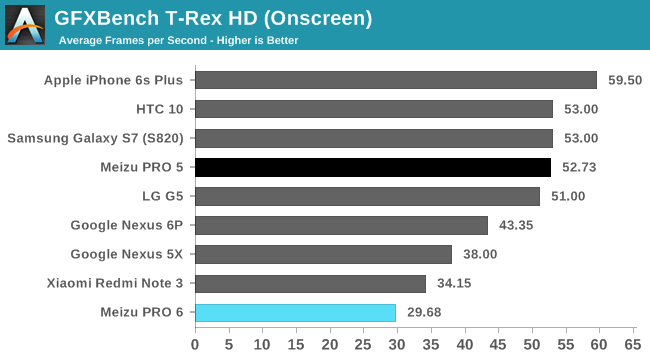
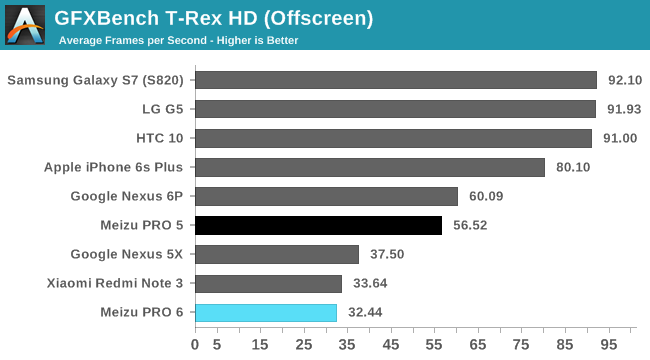
The OpenGL ES 2.0-based T-Rex game simulation combines complex geometry with fewer pixel shading effects than our newer tests and shows just how much better the the PRO 5 is at processing geometry. Twice as many GPU cores brings twice the texturing and ROP performance too, which translates into about a 75% advantage over the PRO 6. The phones with Snapdragon 820 inside outperform the PRO 6 by almost a factor of 3 in the offscreen test.
Thanks to its 1080p display, the PRO 5 pulls even with the Snapdragon 820 phones, whose GPUs are all driving 1440p resolutions, in the onscreen test; however, the PRO 6 is still lags behind, with performance similar to the Xiaomi Redmi Note 3 and its Adreno 510 GPU.
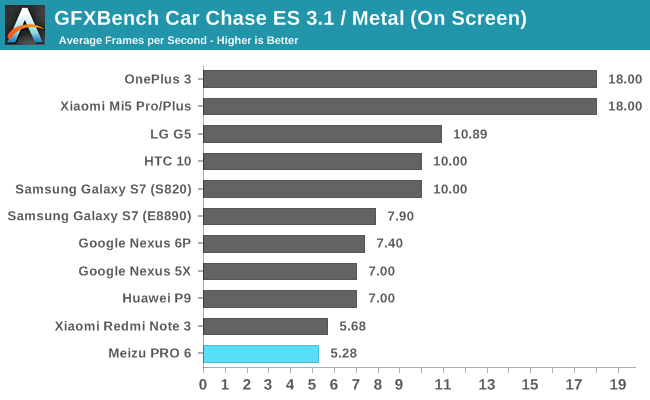
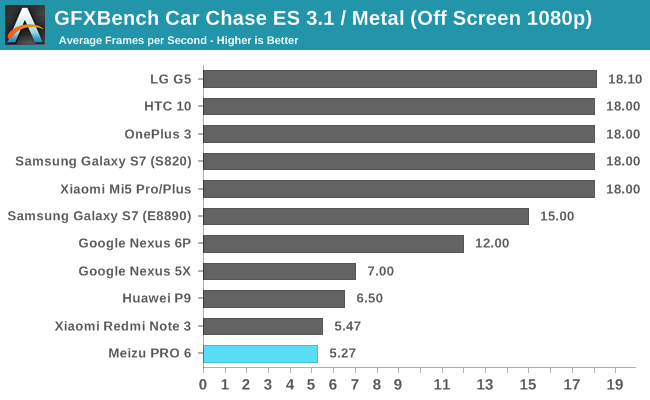
GFXBench Car Chase is a game simulation that uses OpenGL ES 3.1 plus Android Extension Pack (AEP) features such as hardware tessellation. The PRO 5’s graphics driver does not support this last feature, so there’s one less device for comparison. All five Snapdragon 820 phones sit atop both the onscreen and offscreen charts, performing 3x faster than the PRO 6. Even the Huawei P9, which has the same GPU as the PRO 6, performs 23% better.
Digging a little deeper reveals that the P9 is using a newer graphics driver than the PRO 6, whose outdated driver was released back on August 21, 2015. This is the second Meizu phone we’ve tested that suffers from reduced performance and functionality due to outdated graphics drivers, and is definitely something the company needs to pay more attention to in the future.
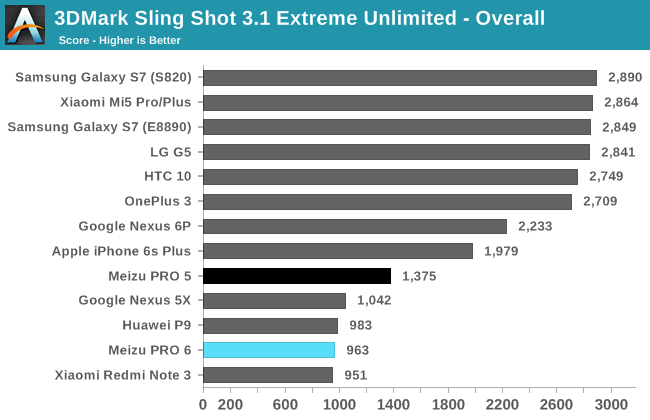
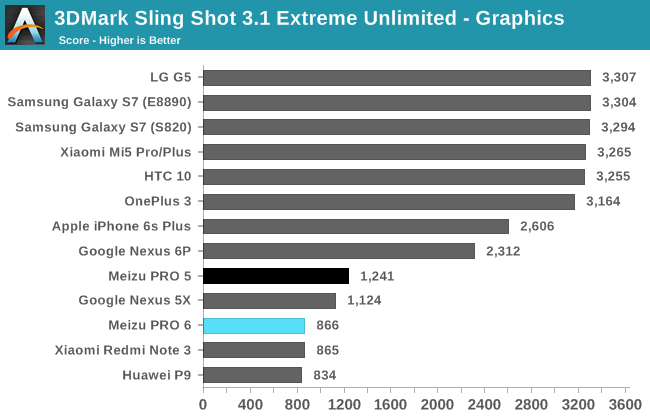
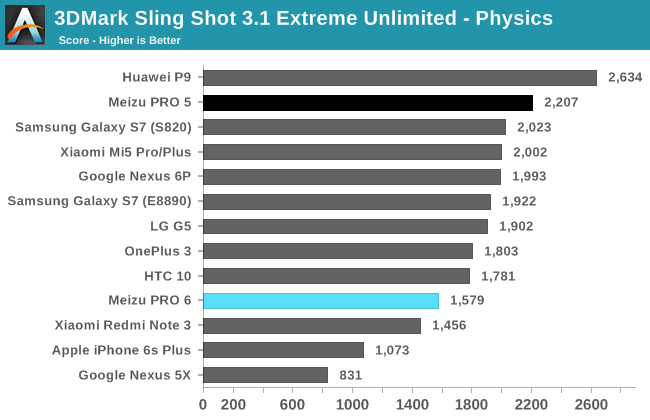
3DMark Sling Shot Extreme runs two different OpenGL ES 3.1 game simulations that stress the GPU and memory subsystems. Despite rendering offscreen at a higher 1440p resolution, there are not any big changes in finishing order. The phones using Snapdragon 820 are still about 3x faster than the PRO 6 in the graphics test, while the PRO 5 performs 43% faster than its younger sibling. The only real surprise is that the PRO 6 performs the same as the Redmi Note 3 and Huawei P9 in the graphics test.
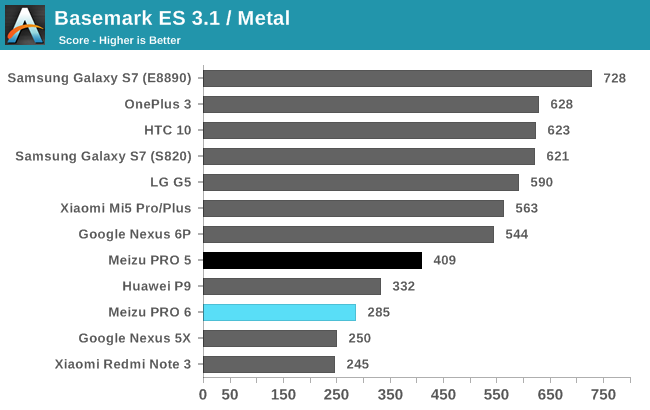
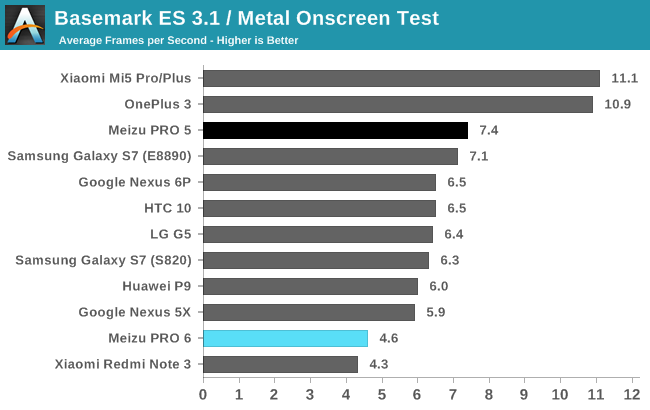
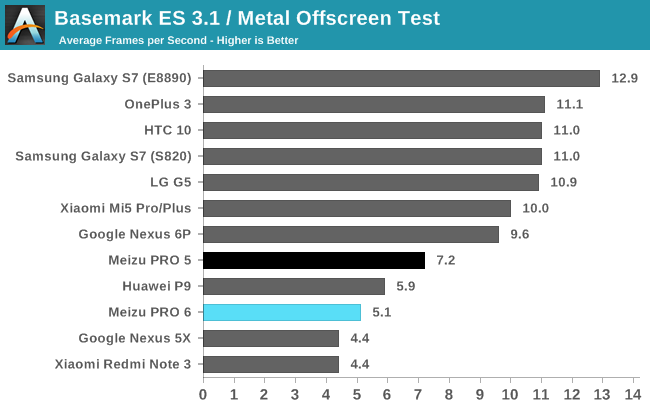
We find the PRO 6 near the bottom of the charts again in Basemark ES 3.1, which makes heavy use of lighting effects with alpha blending and compute shaders for rendering the water. With twice as many ROPs and higher ALU throughput, the PRO 5 performs 44% better than the PRO 6. The P9 performs 16% better than the PRO 6 and extends its advantage to 30% when rendering onscreen even though both phones have 1080p displays. The PRO 6 does perform 16% better than the Redmi Note 3, but the gap shrinks to only 7% when rendering onscreen. We see this discrepancy between offscreen and onscreen performance in GFXBench T-Rex and Car Chase too, which is likely attributable to the PRO 6’s older graphics driver, because the P9 does not have this problem.
Even though the Redmi Note 3 and its Adreno 510 GPU cannot match the peak performance of the latest flagship phones, it’s capable of maintaining playable frame rates above 30fps, with the occasional hiccup, in a number of real games, including “Brothers in Arms 3,” a third-person shooter released at the end of 2014, and “CSR Racing 2,” a popular game based on OpenGL ES 3.0. Considering that the PRO 6 delivers similar performance to the Redmi Note 3 in our GPU tests, it’s reasonable to expect a decent gaming experience from the PRO 6 too.
Unlike our game simulation tests above, however, which focus primarily on GPU performance and memory bandwidth with minimal CPU activity, real games rely on the CPU for running physics, AI, sound, and other algorithms that contribute to the overall gaming experience. To see how the PRO 6 handles real game code, I decided to play several of the same titles I used to evaluate the Redmi Note 3. Starting with “Sonic Dash,” the PRO 6 keeps frame rates between 30-40fps with only an occasional stutter. The PRO 6 also maintains a consistent 30fps when playing the scripted sequences in “Brothers in Arms 3” and “CSR Racing 2;” however, frame rate drops to only 22-27fps during actual gameplay, noticeably less than the 30+fps the Redmi Note 3 is capable of.
Because the drop in frame rate only occurs during gameplay where the CPU is involved, we can examine the core residency times like we did in the previous section to see if CPU utilization is to blame. Indeed, playing the same level in BIA3 shows a distinct difference between the two phones. The PRO 6 only keeps the low-power A53 cluster running at 1.5GHz almost the whole time, and never once powers on the A72 cluster. On the Redmi Note 3, core frequency frequently bounces between idle and 1.3GHz on the A53 cluster, while the A72 cluster spends most of its time at the max frequency of 1.8GHz. Without monitoring the CPU’s run queue, we cannot say how many threads are actually in play and what cores they’re running on, but it’s safe to say the Redmi Note 3 is using its A72 cluster to boost performance.
Thanks to Andrei’s investigation of CPU core utilization on Android, we know that “Modern Combat 5” uses four threads and that the Samsung Galaxy S6 places three threads on the Exynos 7420’s A53 cluster and one heavy thread on the A57 cluster. The Redmi Note 3 seems to follow a similar strategy in this game, with the A53 cluster spending most of its time running near max frequency and the A72 cluster averaging 1.4GHz. The PRO 6, in contrast, primarily uses its mid-tier A53 cluster at its max of 2GHz and keeps its A72 cores offline. This seems to be good enough for MC5, though, because the PRO 6 maintains 30+fps during gameplay.
Based on these data, the Meizu PRO 6 is suitable for casual gaming, but it’s not a good choice for running more intense, 3D games, which is unsatisfactory for a flagship device. Just like we saw in our system performance tests, the PRO 6 fails to utilize the Helio X25’s A72 CPU cores effectively, if at all, and an outdated graphics driver does nothing to aid gaming performance either.










48 Comments
View All Comments
zeeBomb - Friday, August 26, 2016 - link
Meizu Pro 6...not marginally different from the 6, but the next two Meizu flagships are going to be killer (and very Sammy influenced)DParadoxx - Friday, August 26, 2016 - link
I don't know of anyone with any interest in these Chinese phones. I'm not sure why AT keeps reviewing them.serendip - Saturday, August 27, 2016 - link
Because they're cheap and are good value, if you don't mind doing some tinkering to get Google Play onboard and aren't worried about the lack of warranty coverage. Some people don't want to spend $700 outright on the latest Samsung flagship when a $150 Xiaomi would do.Notmyusualid - Saturday, August 27, 2016 - link
^ This!The price of flagship phones is now beyond what I consider reasonable, or necessary. It feel like a Conroe moment in smartphone tech, all the cpus are fast enough for what most people do.
AND - we want dual sim phones too.
I've done six countries this year, and I'm tired to having to keep / charge / carry two dam phones.
My Samsung A9 Pro has a Snapdragon 652, 6" screen, dual sim, seperate miroSD slot, and cost half the S7 Edge. Oh, and it has a 5000mAH battery too.
Colour me impressed.
kmmatney - Sunday, August 28, 2016 - link
I'd rather buy a used Galaxy than one of these, but it's good to see these reviews so you know what your are getting.rms141 - Friday, August 26, 2016 - link
So, the reviewer is going to totally ignore that this thing is a complete iPhone 6S ripoff?mdriftmeyer - Saturday, August 27, 2016 - link
And not at all compare performance because we already know the entire Android platform takes a bath next to iOS on tests.zeeBomb - Monday, August 29, 2016 - link
Still had the design before the iPhone 7...so Apple ripped off Meizu!StormyParis - Friday, August 26, 2016 - link
Thanks, It's interesting to have a first-rate review of a different phone, for once. More useful than an umprteenth review of some flagship: those are already reviewed a lot, and of interest to a lot fewer people.It'd be great to see more such reviews. I'm moving steadily downmarket (used to buy at 500€, then 400€, now 300€) and with the devices' rapid progress, I have never been happier. It's hard to find trustworthy reviews of Chinese midrangers though. I'd like to experiment outside of Honor and Xiaomi; or confirmation than Xiaomi is a Wise CHoice, especially now that htey're releasing "World" version f theire devices with moar bands supported.
StormyParis - Friday, August 26, 2016 - link
It'd also be great to have a chance to correct typos ^^ Sorry.